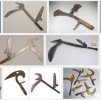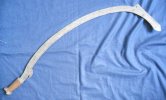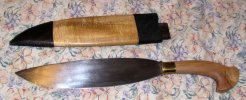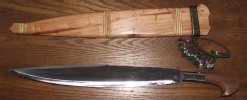just for interest, the african throwing knife ndoghouse mentioned. popular in the southern sudan.

usually a few were carried behind a large hide shield. as mentioned, they did not have wood grips, at most a cord or leather wrap.
i personally think they are ugly, awkward and don't own any, but to each his own.
central & southern africa had evolved a formal warfare routine that was designed to limit fatalities and was conducted gentlemanly, the warring tribes would agree on where & when, they would meet there at the designated time, along with their wives and children as spectators on the sidelines. they would of course have lots of singing and dancing about their ancestral lineages, their deeds and prowess (and beer) before advancing to spear range, throw their spears and advance closer to throw their knives and clubs. they rarely got down to hand to hand. the winner with the one with least casualties, the chiefs would agree on a penalty for the loser. more singing and dancing and they all went home. fatalities were rare. nasty wounds more common.
shaka, the illegitimate son of a shona chief changed all that in the early 19c. he trained his warriors pretty much like romans. his first battle with them, they advanced as usual in formation unlike their opposing mob, threw their spears and recieved those of the enemy, as normal, then charged with their short stabbing spears, used like a roman gladius, the reserves spread around the enemy flanks and rear, trapping them, and the slaughter continued. the zulu empire had arrived. sadly for them, a bit too late as the gun totin' europeans were in the end unstoppable. who knows what the world would have been like if he'd ocurred a few centuries earlier. if the europeans and arabs had come upon a unified africa in the16c arranged along the lines of the spartans and using roman tactics with weapons at least equal, history may have been a lot different.




